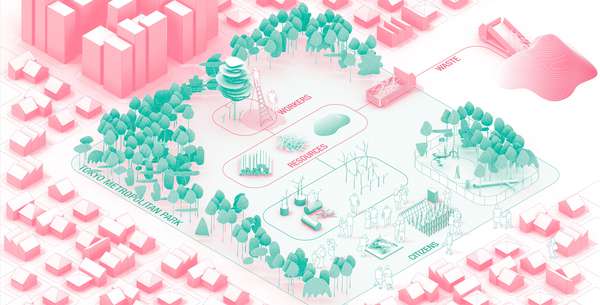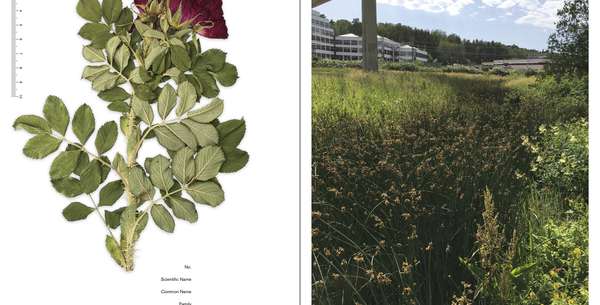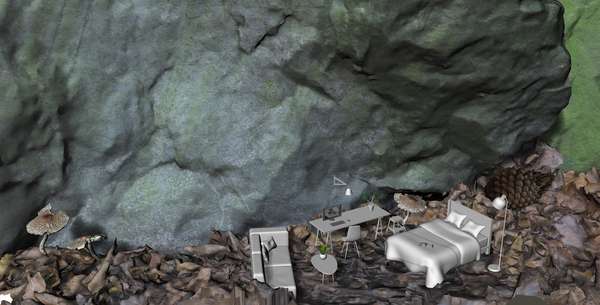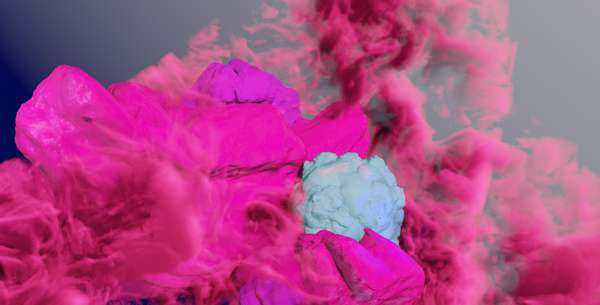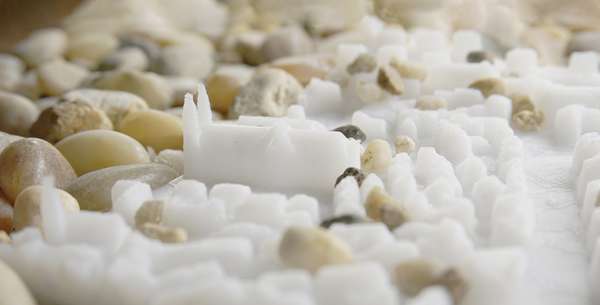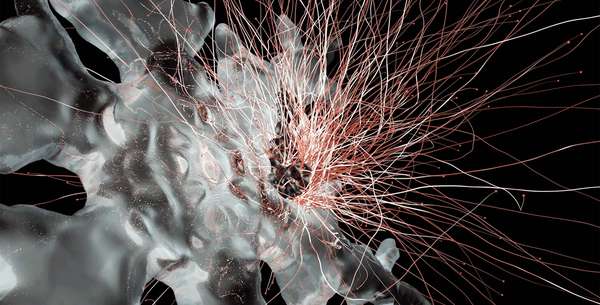Sensing Urban Matter: Fantasies of Seamless Interoperability
Architektūros fondas participates in the Future Architecture Platform programme Landscapes of Care by engaging with practitioners of experimental spatial practice and art with research on variety of environmental technologies and explore the relations between cities, landscapes and information flows.

Fantasies of Seamless Interoperability
a series of online talks with Vladan Joler, Miglė Bareikytė, Rahul Mukherjee and Adriana Knouf
15 September - 22 September - 29 September - 6 October 2021
19.00 EET (18.00 CET) on ZOOM
https://us02web.zoom.us/j/83289992576
*If you would like to receive a notification/reminder before one, some or each of the talks, please register here (optional)
Architektūros fondas invites you to join for a recurring series of talks Fantasies of Seamless Interoperability starting on September 15 as part of Sensing Urban Matter programme. It is a series of four weekly online talks organized by the art-science collaborative Towards Atmospheric Care which explore how collective environmental and social imaginaries, hopes and fantasies are shaped through invisible, yet material and very influential, infrastructure and novel ecosystems emerging at the nexus of political economy, communication technologies and the atmospheric medium in its role as a carrier of the electromagnetic spectrum.
Used as a technical term, 'seamless interoperability’ describes the use of information and communication technologies (ICT) and computer-based tools to achieve information and data exchange between heterogeneous and geographically distributed devices, products, technologies, or systems and organizations. Yet, seamless interoperability is not only about streamlining existing technical operations. Nor is it immaterial any more than the wireless transmission technologies it relies on (such as the emerging 5G and the projected 6G network) which are conditioned by heavily material networks of wires, cables, data centers and protocols. Rather, it is a sociotechnical vision, linked to specific ideologies and material realities with significant transformational impact on society and human environment interactions.
While the technofuturistic projections of the ICT-sector promote efficiency and sustainability deemed profitable for all, the technical complexity of these digital ecosystems render them inaccessible for most people. For the nonexpert – mostly conceived of as the customer – the quirks of technological determinism and modes of mediation, translation and erasure remain sealed within a black box.
Unsettling the ‘seamless’ imaginary of communication technologies, this series of talks looks at the materiality and historical specificity of wireless networks, at noise, errors and leaks with the intent to broaden the discussion on what technoecological networks and digital ecologies we need for communal concerns in the ongoing ecological and social crisis. It departs from a conviction that non-expert engagement – before novel technoecosytems are firmly settled in material, economic and political path dependencies – is crucial to explore possibilities of reparative approaches and alternative futures to the high-tech enclosure of the electromagnetic domain.
The four sessions will reflect on Signal space with Vladan Joler (15.9), Maintenance of the media technology with Miglė Bareikytė (22.9), Radiant infrastructures with Rahul Mukherjee (29.9) and Noise with Adriana Knouf (6.10). Rather than an overview of the subject matter, the series proposes four distinct and different perspectives and practices that bring together critical mapping, conceptual analysis, research and art. Conceived as an exercise in co-learning, the speakers will all share additional resources (texts, work, videos) available here (for the duration of the series).
Through artistic-scientific investigation, the long-term collaboration Towards Atmospheric Care between researcher in ecology Agata Marzecova (Tallinn) and visual artist Hanna Husberg (Stockholm) explores air as a naturalcultural phenomenon, situated in the nexus of media, science and technological mediation. Using installation, performance, writing and critical analysis, they seek to examine the overlapping boundaries between the aesthetic, science and politics of air and the atmosphere. In addition to artistic and academic outcomes, they have developed post-disciplinary pedagogical approaches, including joint teaching of Urban Ethnography at the Estonian Academy of Arts, and co-learning workshops such as the Heavens Field_Notes Laboratory for the Finnish Bioart Society. Their collaboration has been supported by the Technosphere Campus (HKW Berlin, 2016), The Seed Box (Mistra-Formas Collaboratory, 2017), the Bernadotte Fellowship (Konstakademien, 2019-20), Kone Foundation (2020-22), and several residencies.
Sensing Urban Matter project aims to present different creative approaches to urban space and its materiality and how it is connected to wider ecosystems and global networks of logistics, through which matter, raw resources and data circulate. Besides the online talk series, Sensing Urban Matter will present podcast and radio conversations, publication as well as engagements with local urban sites in Lithuania in autumn 2021.
Sensing Urban Matter is part of the Future Architecture Platform and European Architecture programme 2021, co-funded by the Creative Europe Programme of the European Union and a strategic partner Lithuanian Council for Culture. Media partner - Lithuanian national television and radio.
www.archfondas.lt
Abstracts and bios of speakers
Signal space by Vladan Joler
Wednesday, 15.9.2021, 19.00 (EET / GMT)
At this moment in the 21st century, we see a new form of extractivism that is well underway: one that reaches into the furthest corners of the biosphere and the deepest layers of human cognitive and affective being. The stack behind contemporary technological systems goes well beyond the multi-layered ‘technical stack’ of data modeling, hardware, servers and networks. The full stack reaches much further into capital, labor and nature, and demands an enormous amount of each. The true costs of these systems – social, environmental, economic, and political – remain hidden and may stay that way for some time.
Vladan Joler is an academic, researcher and artist whose work blends data investigations, counter-cartography, investigative journalism, writing, data visualisation, critical design and numerous other disciplines. He explores and visualises different technical and social aspects of algorithmic transparency, digital labour exploitation, invisible infrastructures and many other contemporary phenomena in the intersection between technology and society. In 2018, in cooperation with Kate Crawford, he published Anatomy of an AI System, a large-scale map and long-form essay investigating the human labour, data and planetary resources required to build and operate an Amazon Echo device. A previous study of his, entitled Facebook Algorithmic Factory, included deep forensic investigations and visual mapping of the algorithmic processes and forms of exploitation behind the largest social network. Other studies that he authored, published in recent years by the independent research collective SHARE Lab, included research on information warfare, metadata analysis, browsing history exploitation, surveillance, and Internet architecture.
Maintenance of the media technology by Miglė Bareikytė
Wednesday, 22.9.2021, 19.00 (EET / GMT)
Situating the Internet through the three angles of labor, geopolitics and critique Miglė Bareikytė's talk Maintenance of the media technology will present her fieldwork research in Lithuania's telecom industry. In her fieldwork, Bareikytė carried out interviews, observed telecom workers in the company Telia Lietuva as well as carried out archival research within Lithuania's telecom industry. This research aimed to situate and ground what is often perceived as an abstract, immaterial digital media technology – the Internet – in a place that is often neglected in Western-oriented discourses of digitalisation not for the sake of nationalist celebration, but to explicate and complicate narratives around labor, geopolitical imaginaries and critique in a post-socialist realm by taking fieldwork participants utterances and practices seriously. The fieldwork developed between 2017-2018 resulted in her PhD thesis and the upcoming book The Post-Socialist Internet: How Labor, Geopolitics and Critique Produce the Internet in Lithuania with transcript Verlag.
Miglė Bareikytė is a postdoctoral researcher at the University of Siegen, interdisciplinary research project “Organizing Human-Nonhuman Cooperation”. She is interested in situated research of the development and usage of digital technologies as well as their anticipatory claims. Her current research focuses on the topics of algorithmic accountability, geopolitics of AI, and (digital) media ethnography. Her broader research interests comprise infrastructural politics, representation, and distribution of power in Europe. In October 2020, she defended her PhD thesis at the Leuphana University in Lüneburg, Research Training Group “Cultures of Critique” on the topic of situated Internet infrastructure research in post-socialist Lithuania that will be published in January 2022 at Transcript Verlag in English language. Miglė Bareikytė holds degrees in Media studies, Communication Studies, and Political Science from Free University of Berlin, Vilnius University and Vytautas Magnus University.
Radiant Infrastructures by Rahul Mukherjee
Wednesday, 29.9.2021, 19.00 (EET / GMT)
Cell towers and nuclear reactors, like railways and hydroelectric dams, have often been credited as bringing development and progress. But unlike dams and railways, infrastructures like cell antennas and atomic power plants emit radiant energies in the form of electromagnetic signals and radioactive rays. For outward demonstrations of radiance (electrical illumination and information communication), internal operations in nuclear reactors and cell antennas involve invisible processes that scatter radioactive particles and spread electromagnetic rays. Radiant infrastructures as a conceptual heuristic, folds in both these glittering and impalpable aspects of radiance. It is important to go beyond theorizing radiant infrastructures as specific objects, and consider their uncertain environmental (and health) effects along with the wider environments (including air) that the radiation emissions permeate through. Studying radiant infrastructures involves transcending visible light to account for other waves in the electromagnetic spectrum. The uncertain effects of spectral exchanges between infrastructural emissions and human bodies (that mediate radiation) is crucial to theorizing radiant infrastructures. In particular, the talk navigates across phenomenologies of exposure, autonomy, sensitivity, sensing and (wireless) saturation through analysis of case-studies from several regions (India, United States) dealing with biopolitical and infrastructural thresholds.
Rahul Mukherjee is Dick Wolf Associate Professor of Television and New Media and Director of the Cinema and Media Studies program at University of Pennsylvania. His research on environmental media and mobile phone cultures has been published in his recent monograph Radiant Infrastructures: Media, Environment, and Cultures of Uncertainty (Duke University Press, 2020) and in journals such as Media, Culture & Society and Asiascape: Digital Asia. Rahul is part of the advisory board of the journal Media + Environment and the Center for Advanced Research in Global Communication.
Noise by Adriana Knouf
Wednesday, 6.10.2020, 19.00 (EET / GMT)
Noise is both sonic and informatic. From information theoretic definitions that define noise as either the unwanted signal or the source of originality, to sonic definitions that foreground the destructive or constructive possibilities of noise music, noise evades easy categorization. Through an exploration of some of my own artistic practices, especially recent radio art work, as well as those of other allied artists, we will encounter the potentials of noise to disrupt the seemingly stable signal. This disruption cannot be easily valorized as something positive or negative, and instead needs to be understood in its full complexity.
Adriana Knouf, PhD (US) works as an artist, writer, and xenologist. She engages with topics such as wet media, space art, satellites, radio transmission, non-human encounters, drone flight, queer and trans futurities, machine learning, the voice, and papermaking. She is the Founding Facilitator of the tranxxenolab, a nomadic artistic research laboratory that promotes entanglements among entities trans and xeno. Adriana regularly presents her artistic research around the world and beyond, including a work that has flown aboard the International Space Station. Her work has been recognized by a number of awards, including an Award of Distinction at Prix Ars Electronica (2021), an Honorary Mention from the Science Fiction Research Association’s Innovative Research Award, and as a prize winner in The Lake’s Works for Radio #4 (2020).
Enter ROOM 7
